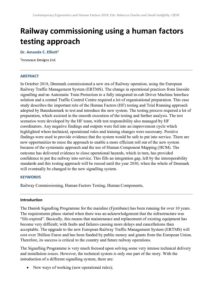| Document | Author Dr. Amanda C. Elliott |
| Abstract In October 2018, Denmark commissioned a new era of Railway operation, using the European Railway Traffic Management System (ERTMS). The change in operational practices from lineside signalling and no Automatic Train Protection to a fully integrated in-cab Driver Machine Interface solution and a central Traffic Control Centre required a lot of organisational preparation. This case study describes the important role of the Human Factors (HF) testing and Trial Running approach adopted by Banedanmark to test and introduce the new system. The testing process required a lot of preparation, which assisted in the smooth execution of the testing and further analysis. The test scenarios were developed by the HF team, with test responsibility also managed by HF coordinators. Any negative findings and outputs were fed into an improvement cycle which highlighted where technical, operational rules and training changes were necessary. Positive findings were used to provide evidence that the system would be safe to put into service. There are now opportunities to reuse the approach to enable a more efficient roll out of the new system because of the systematic approach and the use of Human Component Mapping (HCM). The outcome has delivered evidence to close operational hazards, which in turn, has provided confidence to put the railway into service. This fills an integration gap, left by the interoperability standards and this testing approach will be reused until the year 2030, when the whole of Denmark will eventually be changed to the new signalling system. |

